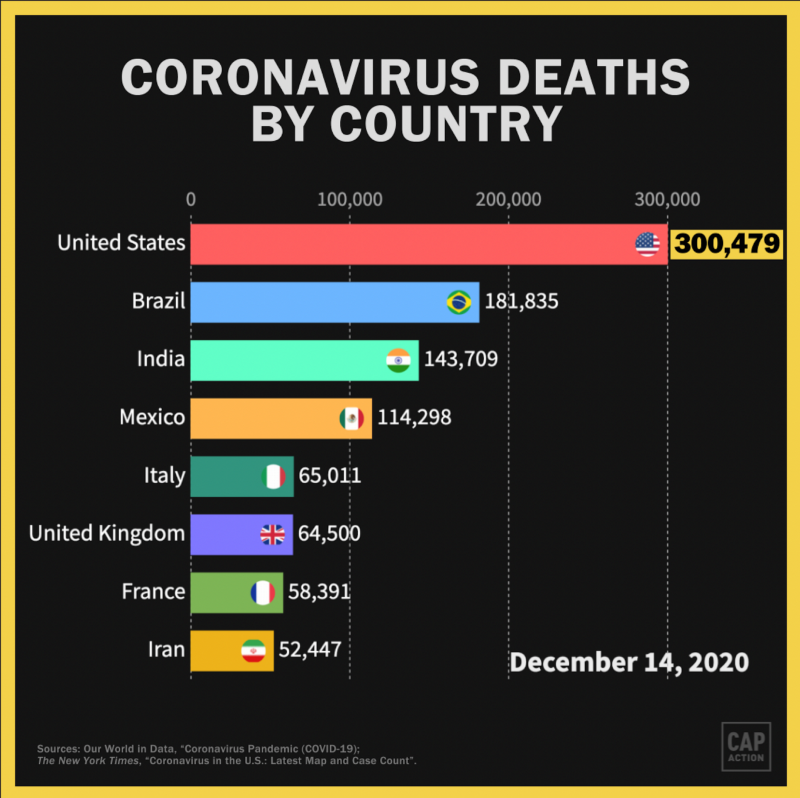This piece was originally published in the December 15, 2020 edition of CAP Action’s daily newsletter, the Progress Report. Subscribe to the Progress Report here.
 Photo by Maria Oswalt on Unsplash
Photo by Maria Oswalt on Unsplash
— Rep. Maxine Waters (D-CA)
McConnell and Trump left millions to suffer and now 300,000+ to die — many painfully and alone. It didn’t have to be like this.
Share this on Twitter and Facebook to get the facts out:

- The clock is ticking on an end-of-year pandemic relief bill, with lawmakers feeling the pressure to pass something by the end of this week. We’ve said this before, but if anything is going to pass, it is almost certainly going to happen by Friday. If not because of the pressing urgency of millions suffering from months of unprecedented financial and physical strain, then at least because Congress would like to wrap things up in time to go home for the holidays instead of sticking around in D.C. to finalize a bill. We know, it’s bleak out there.
- The latest proposal, which remains at the previously discussed $908 billion total price tag, would split the various provisions into two bills. One bill would contain the things each side is refusing to cut. For Democrats, that’s the “radical” idea of making sure states can afford to keep their governments running in the middle of a public health crisis. For McConnell and his caucus, that’s making sure their corporate friends aren’t subject to federal laws that exist to hold them accountable for workplace safety and health violations. In the middle of a public health crisis!
- The second bill would contain everything else — including, ideally, these other items that urgently need to be addressed and funded. What it wouldn’t contain, at least as of the time we’re writing this, is stimulus checks.
- The idea is that if Congress can’t work out a deal on the two contested provisions, they might *at least* be able to pass the rest separately. It’s the bare minimum, and honestly a little less than that considering how long overdue Congressional action is. CAP Action’s sister organization released a statement on the bill as a first step, which you can read here.
- Members of House and Senate leadership were set to convene late this afternoon for what looks like the final stretch of negotiations on the bills. Things are changing rapidly, so we’d suggest following one of these reporters for the latest updates.
- Meanwhile, some members of Congress aren’t backing down in their fight to ensure Americans get some sort of direct payment as part of these negotiations. Senator Bernie Sanders (I-VT) and Congresswoman Pramila Jayapal (D-WA), along with all of these progressive House members, are still holding strong on including the payments. “Congress can’t go home for the Christmas holidays until we pass legislation which provides a $1,200 direct payment to working class adults, $2,400 for couples and $500 for kids,” Sanders tweeted earlier. Again, there’s bipartisan support for sending checks to people — including from conservative Senator Josh Hawley (R-MO) and even Trump himself.
IN CASE YOU MISSED IT
- It’s day two of the Pfizer vaccine rolling out to health care workers and nursing homes across America. Since the same vaccine went into use in the U.K. last week, no major issues have arisen, and American health care workers who’ve received the shot say the experience is no different from getting any other vaccine. While there have been a couple reports out of the U.K. of allergic reactions, experts say this is not cause for panic. Experts like Dr. Fauci say people with allergies should talk to their doctors before getting the vaccine and undergo the normal precautions in case a reaction occurs — as in, if you usually carry an EpiPen, don’t forget to bring it with you.
- Pfizer’s vaccine is not the only one that could be approved for emergency use in the U.S. in the coming weeks. The Moderna-NIH vaccine, which showed similarly promising results in trials and was developed in part through federal research, is progressing through the approval pipeline and will reportedly soon be up for review under the same type of emergency authorization Pfizer has received. And rest assured that no matter which vaccine you end up getting, America’s health care workers are going above and beyond to prepare for a safe and accessible vaccine rollout.
- A new study found that more than half a million coronavirus cases in the U.S. this summer were linked to prisons and jails. Let’s break down what that means with more data from the Prison Policy Project. Roughly 13% of ALL coronavirus cases in the U.S. from May 1 through August 1 could be traced back to mass incarceration. If America’s carceral system were a country, it would be ranked fifth globally based on the number of coronavirus cases linked to prisons and jails. Read the full report here.
- We have seen time and time again that incarcerated people are among the hardest hit by COVID-19. And yet, as similarly impacted nursing home residents and staff are already receiving the vaccine in many states, incarcerated people have been left out of vaccination plans entirely in at least ten states. Here’s why that’s not okay, aside from the obvious cruelty and negligence, and here’s what one state is doing to ensure incarcerated people receive proper priority for the vaccine.
WHAT WE’RE READING